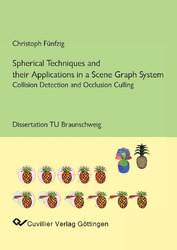| Fachbereiche | |
|---|---|
| Buchreihen (96) |
1379
|
| Nachhaltigkeit |
3
|
| Gesundheitswesen |
1
|
| Geisteswissenschaften |
2367
|
| Naturwissenschaften |
5407
|
| Mathematik | 229 |
| Informatik | 319 |
| Physik | 980 |
| Chemie | 1364 |
| Geowissenschaften | 131 |
| Humanmedizin | 243 |
| Zahn-, Mund- und Kieferheilkunde | 10 |
| Veterinärmedizin | 108 |
| Pharmazie | 147 |
| Biologie | 835 |
| Biochemie, Molekularbiologie, Gentechnologie | 121 |
| Biophysik | 25 |
| Ernährungs- und Haushaltswissenschaften | 45 |
| Land- und Agrarwissenschaften | 1004 |
| Forstwissenschaften | 201 |
| Gartenbauwissenschaft | 20 |
| Umweltforschung, Ökologie und Landespflege | 148 |
| Ingenieurwissenschaften |
1793
|
| Allgemein |
98
|
|
Leitlinien Unfallchirurgie
5. Auflage bestellen |
|
Erweiterte Suche
Spherical Techniques and their Applications in a Scene Graph System: Collision Detection and Occlusion Culling
Christoph Fünfzig (Autor)Vorschau
Inhaltsverzeichnis, Datei (37 KB)
Leseprobe, Datei (260 KB)
For physical simulation and a natural interaction with models in virtual environments the detection of collisions is an enabling technology. In this thesis a full system for collision detection is demonstrated, which incorporates classic and new approaches. Due to the wealth of different model representations this work concentrates on polygonal models and on Catmull-Clark subdivision surfaces for freeform models, which are also available in the scene graph system OpenSG. Concerning model changes this work covers movements (translations, rotations, scalings) and topology-preserving deformations.
Besides bounding volume hierarchies this thesis covers alternative approaches using spherical model representations. With these representations model rotations and model scalings can be handled easily. The first representation as a hierarchical spherical distance field samples the model in a regular way. The resulting algorithm for collision detection is efficient and allows for flexible collision information. Additionally, the hierarchical distance field can be compressed and decompressed without considerably compromising the runtime. For deformations, the theory of spherical Bézier surfaces allows to compute a spherical approximation of a polygonal model for a fixed spherical triangulation. In this work a spherical Bézier representation has been used for the first time to prevent further consideration of large model parts during collision detection of deformable models.
For Catmull-Clark subdivision surfaces, our contribution is a Bézier approximation for surface patches. This has the advantage that patchwise distances can be computed with well-known numerical algorithms, and compact, convex bounding volumes can be generated for surface parts as required for collision detection.
Finally, new optimizations of occlusion culling are presented as an important technique for rendering time improvement in the scene graph system OpenSG.
| ISBN-13 (Printausgabe) | 3867271119 |
| ISBN-13 (Printausgabe) | 9783867271110 |
| ISBN-13 (E-Book) | 9783736921115 |
| Buchendformat | A5 |
| Sprache | Englisch |
| Seitenanzahl | 168 |
| Auflage | 1 |
| Band | 0 |
| Erscheinungsort | Göttingen |
| Promotionsort | Braunschweig |
| Erscheinungsdatum | 09.01.2007 |
| Allgemeine Einordnung | Dissertation |
| Fachbereiche |
Informatik
Allgemeine Ingenieurwissenschaften |
| Schlagwörter | Physikalische Simulation, Kollisionserkennung, Sphärisches Distanzfeld, Computergrafik, Occlusion Culling. |








